Article du C-U: Ebertfest X, pt.6
“The Big Ten”
Roger Ebert’s Film Festival reaches the end of a decade – but without its founder and host
by Anthony Zoubek
~~~~~
THE CELL WAS EBERTFEST’S HULK. The film’s near-midnight start time weeded out some of the festival’s older, conservative regulars who might frown upon one of the movie’s memorable and disquieting images – serial killer Carl Stargher (Vincent D’Onofrio), suspended in air from hooks embedded in his back, masturbating on the milk-white, doll-like corpse of his latest victim.
In his preview coverage, eFilmCritic.com contributor Peter Sobczynski declared the hard R-rated European version of THE CELL to be screened at Roger Ebert’s Film Festival “easily the most controversial selection of this year’s festival.” (Actually, that crown goes to THE BAND’S VISIT, a soulfully sweet-natured and mostly Arabic-language film banned in many Middle Eastern countries for melding Israelis and Palestinians in its cast as well as ousted from Academy Award consideration due to its use of “too much English.”) However, Sobczynski was dead on in his assertion that THE CELL would “be worth watching it again just to see how it goes down with the Ebertfest crowd.”
For most of us, THE CELL was best described by Chaz Ebert in her prefatory remarks. “This movie is a feast for the eyes,” she said, “although I must admit, sometimes I need to hide my eyes.”
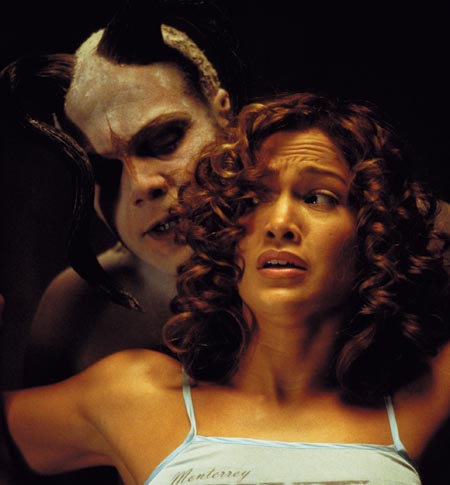
Chaz then turned the microphone over to film scholar David Bordwell, who expounded on the intellectual curiosities provoked by the movie’s aesthetics. “Filmmaking has always been open to influence from other arts,” he explained. “Movies have always been a scavenging medium. Visually, THE CELL creates as many new and bold ideas as the ones it creatively borrows from elsewhere.
“I have a rule when I watch movies,” Bordwell continued, “and that is, show me at least three things I’ve never seen before. Well, tonight, you will see a few hundred things you’ve probably never seen before.”
Citing its director, Tarsem Singh (“a visual visionary”), and the film’s costumer, Eiko Ishioka (on whose production design work, including MISHIMA – the very best film of Ebertfest 2008 – “we could do an entire film festival”), Bordwell called THE CELL a “representative of the future of cinema; an involving, evolving, highly experimental approach to an archetypal midnight movie in some respects and an aesthetic gallery in others.”
Singh, whom Bordwell invited on stage, said he would keep his pre-movie comments brief (“because I don’t want to spoil it for you”) right before launching into a humorously lengthy and rapidly-paced tirade about the movie’s sometimes nauseating, always hypnotic iconography. Singh’s enthusiasm, as sprightly as THE CELL itself, was so kinetic that even a prototypical Quentin Tarantino rant would sound haggard in comparison. “If you feel you need to walk out during the movie,” he quipped, “then walk out – I won’t mind.”
In the Virginia Theatre balcony, there were a total of eight walk-outs before the aforementioned suspension sequence. (This scene only lasts about a minute in the American version. Ebertfest audiences were treated to the gruesome seven-minute European version.) Pity to those who did not allow the actual plot of the film to engross them.
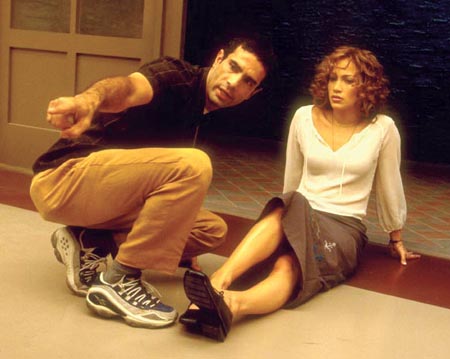
THE CELL’s unbalanced screenplay, particularly hackneyed for the film’s first half-hour, certainly didn’t help. Jennifer Lopez stars as Catherine, a social worker with the technology to link the inner recesses of her mind to that of a patient in psychological need. (The movie’s opening images of Lopez wearing a white dress, crossing sand dunes while riding a white stallion – supposedly “in” the mind of a comatose boy who probably wouldn’t dream of horses and desert vistas – is laughably pretentious.) In an analogous but seemingly unrelated story line, an FBI team lead by Agent Novak (Vince Vaughn) captures the psychopathic Stargher, who kidnaps young women and locks them in a timed torture chamber that eventually kills them.
With Stargher in captivity, his latest victim is still at large, locked in the killing machine. The only way to save the girl is to allow Catherine to enter Stargher’s mind, a wildly prophetic Jung-esque juxtaposition of the killer’s brutal childhood, perverted adult dreamscapes, and a pastiche of late-1990s MTV music video semiotics and syntax, packed with enough surreal imagery to make Salvador Dali weep. It’s astounding how early THE CELL feels like it may slide into two-star CAPTIVITY and THE HILLS HAVE EYES country and how quickly its visually operatic tone turns the aesthetics into something akin to 2001: A SPACE ODYSSEY.
Only when we are seduced by its style does the story put us under its spell, the silly script becoming a misnomer to Singh’s hyperactive imagination and Ishioka’s design. Whereas introductory scenes put more focus on Lopez’s backside than her expository characterization, the journeys into Stargher’s mind earn our empathy and make Catherine a three-dimensional heroine. After her first trip “in,” Catherine and Agent Novak catch a breath of fresh air outside the psych ward and the ensuing debate – nature versus nurture in turning the psychologically unnerved mind into the impulse of a cold-blooded killer – is engaging, fascinating, and ultimately heartbreaking. A subtle moment delivered brilliantly by Vaughn, insinuating a vital piece of information about his agent’s past, makes us realize how much we care about these two characters and the outcome of their plight.
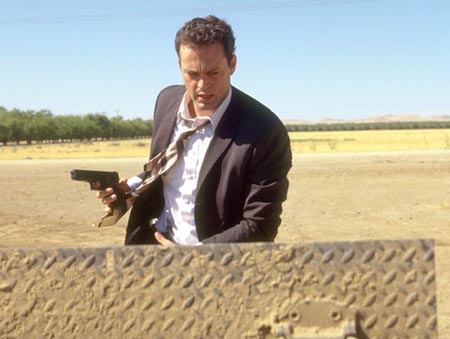
By the end of the film, we realize Singh’s popcorn opus may well have ushered in a visual style for the new millennium, for better or worse. He borrows from Trent Reznor, Carmen, French New Wave, German Expressionism, Italian Neo-Realism, Grand Guignol, and even his own “Losing My Religion” video for R.E.M. The film’s detractors called it THE SILENCE OF THE LAMBS meets THE LAWNMOWER MAN. I prefer the more accurate EL TOPO meets SE7EN.
~~~~~
FOLLOWING THE SCREENING, Singh said he allowed his imagination to take advantage of “a somewhat stupid script” that was “limited to scenes with five lines: ‘She’s taken by the killer and shown his victims … she’s shown the killer’s nightmare.’ That would be it. Where do I go with that? Well, women who pump iron scare the fuck out of me. That’s it! Iron-pumping women! That’s how we’d fill in the script’s blanks.
“The script was secondary,” he added. “We used iconography and poetic logic to create links between sets and themes.” Singh also said Ishioka’s input helped make THE CELL’s visuals “create mythologies of the subconscious mind, tranquility versus turbulence. She researched books on saints, Vanier – her mind is full of religion and [the] opera world. Forget about thinking outside the box. She doesn’t even know what or where the box is.”
New Line Cinema, distributor of THE CELL, wanted eye candy. Singh aimed to please. “First came the designs, then we went back and added the set-ups,” he explained. “When the virtual reality suits took on the look of water suits, we added water beds and water motifs in introductory scenes. If we decided we wanted to make a fantasy sequence look like the inside of a snow globe, we would plug in a real snow globe in a set-up scene. Our desired set designs for the surreal scenes prompted us to insert some sort of establishing hint in early expository scenes.”
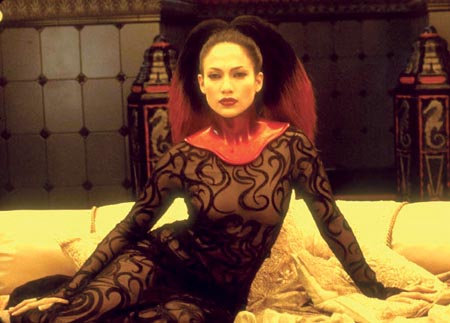
One of the movie’s most bizarre sequences, featuring a standing horse being cut into deli-thin slices, almost got Singh sued by the creators of the touring “Body Works” museum exhibition which features biological installations that look identical to the director’s baroque imagery.
Singh said negative press reaction to the film came “because the movie was screened for critics before any of the special effects were done. Fortunately, Roger [Ebert] was on a holiday and eventually saw the film when it was actually finished. Only days before the film came out in theaters did the studio get behind the movie and realize that they might have something.”
Despite its superiority over the North American version, the longer international cut is not the director’s cut of THE CELL. “A true director’s cut would cut out all of the dialogue, insert explanatory title cards like a silent movie, and feature only Howard Shore’s score [on the soundtrack],” Singh said with a grin.
~~~~~
“The Big Ten” pt.7 coming soon!
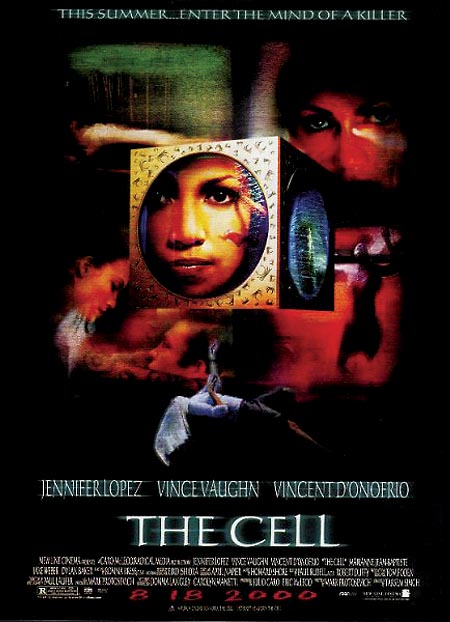
THE CELL is a production of Caro-McLeod/Radical Media distributed theatrically by New Line Cinema and on DVD by New Line Home Entertainment. It was directed by Tarsem Singh, produced by Julio Caro and Eric McLeod, and written by Mark Protosevich, and stars Jennifer Lopez, Vince Vaughn, Vincent D’Onofrio, Marianne Jean-Baptiste, Jake Weber, and Dylan Baker. 2000, 35mm, Color, 108 minutes.
~~~~~
“The Big Ten” pt. 6 © 2009 Anthony Zoubek. Used with permission.
CUBlog edit © 2009 Jason Pankoke
All graphics © 2000 New Line Home Entertainment